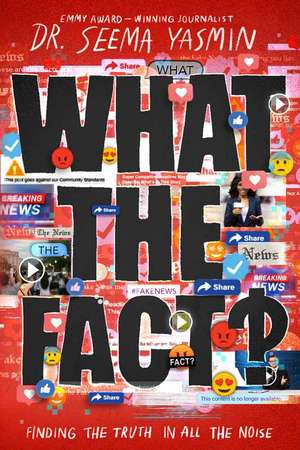What the Fact?
Autor Seema Yasminen Limba Engleză Paperback – 10 oct 2023 – vârsta până la 17 ani
What is a fact? What are reliable sources? What is news? What is fake news? How can anyone make sense of it anymore? Well, we have to. As conspiracy theories and online hoaxes increasingly become a part of our national discourse and “truth” itself is being questioned, it has never been more vital to build the discernment necessary to tell fact from fiction, and media literacy has never been more important.
In this accessible guide, Dr. Seema Yasmin, an award-winning journalist, scientist, medical professional, and professor, traces the spread of misinformation and disinformation through our fast-moving media landscape and teaches young readers the skills that will help them identify and counter poorly-sourced clickbait and misleading headlines.
| Toate formatele și edițiile | Preț | Express |
|---|---|---|
| Paperback (1) | 77.06 lei 3-5 săpt. | |
| Simon Spotlight – 10 oct 2023 | 77.06 lei 3-5 săpt. | |
| Hardback (1) | 115.05 lei 3-5 săpt. | |
| Simon & Schuster Books for Young Readers – 23 noi 2022 | 115.05 lei 3-5 săpt. |
Preț: 77.06 lei
Nou
14.74€ • 15.40$ • 12.18£
Carte disponibilă
Livrare economică 25 martie-08 aprilie
Specificații
ISBN-10: 1665900040
Pagini: 368
Dimensiuni: 138 x 206 x 25 mm
Greutate: 0.34 kg
Ediția:Reprint edition
Editura: Simon Spotlight
Notă biografică
Extras
CHAPTER 1 CONTAGIOUS INFORMATION
ON THE AFTERNOON of February 27, 2020, Peter Lee Goodchild, an 84-year-old retired art gallery owner from Buckinghamshire, England, posted a message on his Facebook page. “Last evening dining out with friends, one of their uncles, who’s graduated with a master’s degree and who worked in Shenzhen Hospital (Guangdong Province, China) sent him the following notes on Coronavirus for guidance…”
Peter’s Facebook post offered a friendly list of warnings and tips about a new coronavirus that had sprung up in China around Christmas 2019. The infection was quickly making its way around the world. “If someone sneezes with it, it takes about 10 feet before it drops to the ground and is no longer airborne,” wrote Peter, via his friend’s uncle.
A post containing all sorts of nonsense about the novel coronavirus went viral on Facebook in the early days of the COVID-19 pandemic. Source: Snopes.com.
Pictured is one version of the viral Facebook post that was shared in February 2020. The post “mutated” over time as it was updated, shared, and translated into dozens of languages.
Peter’s post included advice about swishing the throat with liquid to prevent infection: “A simple solution of salt in warm water will suffice,” he said. He included a timeline of the illness that said the virus “will first infect the throat, so you may have a sore throat lasting 3/4 days. The virus then blends into a nasal fluid that enters the trachea and then the lungs, causing pneumonia.”
Peter also issued this warning: “The nasal congestion is not like the normal kind. It can feel like you’re drowning.” There were even details about exactly how many hours this new virus could survive on metal and fabric, alongside advice to avoid ice-cold drinks.
Peter’s Facebook post was liked by his friends, who shared it with their friends, who shared it with their friends… until it was shared more than 400,000 times in a matter of days. And that was just on Facebook.
A few days after Peter hit “post,” his Facebook message went from Buckinghamshire to Melbourne, from Hong Kong to Cape Town and beyond. Translated into Arabic, Spanish, French, Italian, Amharic—around a dozen languages in all—Peter’s list of tips and warnings popped up on websites, on internet message boards, and in private group chats from Bali to Bologna.
Peter’s virus post was read by millions of people all over the planet. Peter had gone viral.
The problem was this: Most of Peter’s viral message about the new virus was nonsense. Throat gargles don’t get rid of the coronavirus that causes COVID-19. Avoiding icy drinks won’t obliterate the infection. And had you asked any honest scientist back in February 2020 about the exact timeline of infection and how long the virus lingered on metals and fabrics, they would have said, “Umm, can I get back to you on that? We’re still trying to figure it out.”
But it didn’t matter that Peter’s message was mostly nonsense. A new disease was spreading, fear was brewing, and people were desperate for information. And here, right when we were ravenous for facts and figures, was a helpful post from a man whose Facebook profile photo showed a smiling, grandfatherly face.
Recenzii
"Laden with entertainingly presented tips and techniques, this informative overview will encourage further exploration and contemplation.
A savvy, accessible, and critical guide to media literacy."
"Journalist Yasmin (If God Is a Virus, for adults) effectively explores contemporary media literacy’s barriers and how to overcome them in this eye-opening work told via contagion and vaccine metaphor."
Descriere
From acclaimed writer, journalist, and physician Dr. Seema Yasmin comes a much-needed, timely book about the importance of media literacy, fact-based reporting, and the ability to discern truth from lies.
What is a fact? What are reliable sources? What is news? What is fake news? How can anyone make sense of it anymore? Well, we have to. As conspiracy theories and online hoaxes increasingly become a part of our national discourse and “truth” itself is being questioned, it has never been more vital to build the discernment necessary to tell fact from fiction, and media literacy has never been more vital.
In this accessible guide, Dr. Seema Yasmin, an award-winning journalist, scientist, medical professional, and professor, traces the spread of misinformation and disinformation through our fast-moving media landscape and teaches young readers the skills that will help them identify and counter poorly-sourced clickbait and misleading headlines.
